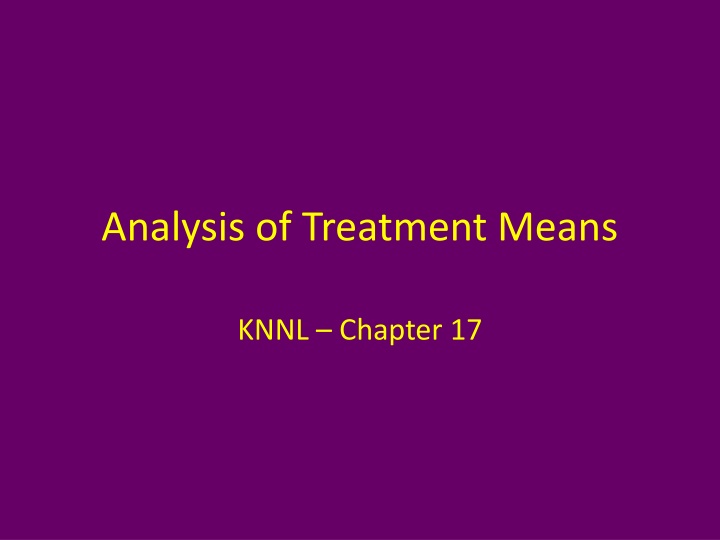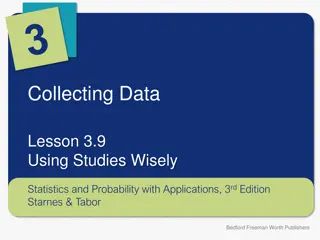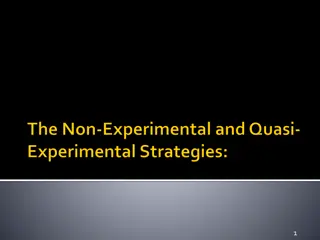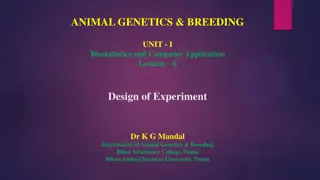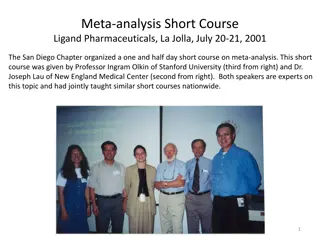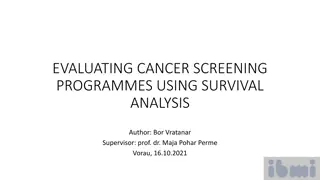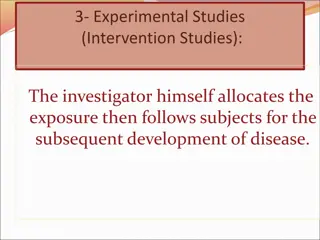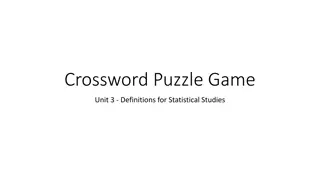Statistical Analysis of Treatment Means in Experimental Studies
The content discusses various statistical methods to analyze treatment means in experimental studies, including KNNL models, main effects plots, inference for individual treatment means, comparing two treatment means, and contrasts among treatment means. It covers topics such as parameter estimation, confidence intervals, test statistics, and linear contrasts. The analysis includes graphical representations and interpretations to understand the significance of treatment effects.
Download Presentation

Please find below an Image/Link to download the presentation.
The content on the website is provided AS IS for your information and personal use only. It may not be sold, licensed, or shared on other websites without obtaining consent from the author.If you encounter any issues during the download, it is possible that the publisher has removed the file from their server.
You are allowed to download the files provided on this website for personal or commercial use, subject to the condition that they are used lawfully. All files are the property of their respective owners.
The content on the website is provided AS IS for your information and personal use only. It may not be sold, licensed, or shared on other websites without obtaining consent from the author.
E N D
Presentation Transcript
Analysis of Treatment Means KNNL Chapter 17
Cell Means Model Sampling Distributions and Graphs ( ) ( ) 1 j i n = + = = 2 Model: ~ 0, 1,..., 1,..., Y NID i r j n ij i ij ij i 2 Fixed Effects ~ , independent Y N ij i n 2 1 MSE n ^ i = = = = = 2 2 Y Y E Y Y s Y i i i i i ij i n = i i 2 Y ( ) i ~ , independent ~ i Y N t n r i i T n s Y i i Bar Graph - Lifeboat Training Main Effects Plot - Lifeboat Training 9.000 8.000 8.000 7.500 Procedural Knowledge 7.000 7.000 6.000 6.500 6.000 5.000 Mean 5.500 4.000 Allmean 5.000 3.000 4.500 2.000 4.000 1.000 0 1 2 3 4 5 Teaching Method 0.000 1 2 3 4
Inference for Individual Treatment Means s Y Y MSE n ( ) i = ~ where i t n r s Y i T i i ) r s Y ( ( ) ( ) 1 100% Confidence Interval for : 1 2 ; Y t n i i i T = Test of : vs : H c H c 0 i A i Y c ( ) ( ) i = * * Test Statistic: Reject if 1 2 ; t H t t n r s Y 0 T i Note: The t-distribtion arises from: Y SSE ( ) i 2 n 1) ~ 0,1 2) ~ 3) , are independent i N Y SSE Y i r 2 T i
Comparing Two Treatment Means = Parameter: Difference between 2 Treatment Population Means D ' i i ^ = Estimator: Difference between 2 Treatment Sample Means D Y Y ' i i 1 n 1 n ^ ^ = = + = + 2 2 2 2 E D D Y Y ' i i ' i i ' i i 1 n 1 n 1 n 1 n ^ ^ = + = + 2 s D MSE s D MSE ' ' i i i i ) ^ D D ^ ^ ( ( ) ( ) ( ) D t ~ 1 100% CI for : 1 2 ; t n r D n r s D T T ^ s D ( ) ( ) = = Test of : 0 vs : 0 H D H D 0 ' ' i i A i i ^ D ( ) ( ) = * * Test Statistic: Reject if 1 2 ; t H t t n r 0 T ^ s D
Contrasts among Treatment Means Contrast: A Linear Function of Treatment with their coefficients summing to 0: r r = = such that 0 (Note: A difference between 2 means is contrast) L c c i i i = = 1 1 i i 2 i 2 c n r r r r r MSE n ^ L ^ ^ L ^ L = = = = = = 2 2 i 2 2 i c Y E L L c c s c MSE i i i i n = = = = = 1 1 1 1 1 i i i i i i i i ) ^ L L ^ L t ^ ( ( ) ( ) ( ) ~ 1 100% CI for : 1 2 ; t n r L n r s L T T ^ s L r r = = = Test of : 0 vs : 0 H L c H L c 0 i i A i i = = 1 1 i i r c Y ^ L i i ( ) ( ) = = * * = Test Statistic: Reject if 1 2 ; 1 i t H t t n r 0 T ^ 2 i r c n s L MSE = 1 i i 2 ^ L SSL MSE H ( ) 0 = Contrast Sum of Squares: ~ 1, SSL F n r T 2 i r c n = 1 i i SSL MSE ( ) = * * Test Statistic: Reject if 1 ;1, F H F F n r 0 T
Example Virtual Training of Lifeboat Task Treatments - k = 4 Methods of Virtual Training (n=16) 1: Traditional Lecture and Materials (LEC/MAT) 2: Computer Monitor / Keyboard (MON/KEY) 3: Head Mounted Display / Joypad (HMD/JPD) 4: Head Mounted Display / Wearable Sensors (HMD/WEA) Consider 3 Contrasts: L1: 1 vs (2,3,4): Traditional versus Computer/HMD L1: a1= 3, a2= a3= a4= -1 L2: 2 vs (3,4): Computer versus HMD L2: b1= 0, b2= 2, b3= b4= -1 L3: 3 vs 4: HMD/JPD vs HMD/WEA L3: d1= d2= 0, d3= 1, d4= -1
Orthogonal Contrasts & Sums of Squares r r r r = = = = Two Contrasts: 0 L a L b a b 1 2 i i i i i i = = = = 1 1 1 1 i i i i ab r r = = , are orthogonal if: 0 for balanced data, 0 i i n L L ab 1 2 i i = = 1 1 i i i 2 2 2 r r ^ L ^ a Y n L i i = = = = 1 i Contrast Sum of Squares: for balanced data, SSL SSL 2 i 2 i r r a n a n 2 i a = 1 = = i 1 1 i i i i Among treatments, we can obtain Then, we can decompose the Between Treatment Sum of Squares into the ... where each of the Contrast Sums of Squares has 1 degree of freedom r SSTR SSL SSL = + + 1 pairwise orthogonal Contrasts: ,..., r r L L 1 1 r Contrasts: 1 1
Example Virtual Training of Lifeboat Task Trt (i) 1 2 3 4 Sum Label LEC/MAT MON/KEY HMD/JOY HMD/WEA n_i 16 16 16 16 64 ybar_i 4.931 7.708 6.736 6.875 a_i 3 -1 -1 -1 0 b_i 0 2 -1 -1 0 d_i 0 0 1 -1 0 L1 L2 0 L3 0 0 a_i^2/n_i b_i^2/n_i d_i^2/n_i 0.5625 0 0.0625 0.25 0.0625 0.0625 0.0625 0.0625 0.75 0.375 14.793 -7.708 -6.736 -6.875 -6.526 0 0 15.416 -6.736 -6.875 1.805 6.736 -6.875 -0.139 0.0625 0.0625 0.125 = = 64 4 = = 4.430 60 2.000 MSE n r .975,60 t T ^ L = = Contrast 1: 3 6.526 Y Y Y Y 1 1 2 3 4 2 i a n ^ ( ) = = = 4.430 0.750 1.823 s L MSE 1 i ( ) ( ) 6.526 2.000 1.823 10.172, 2.880 95% CI: 6.526 3.646 6.526 1.823 = = = test: : 0 : 0 : 3 .580 t H L H L TS t 0 1 1 1 A L ( ) = = 2 3.580 .0007 P P t 60
Example Virtual Training of Lifeboat Task Trt (i) 1 2 3 4 Sum Label LEC/MAT MON/KEY HMD/JOY HMD/WEA n_i 16 16 16 16 64 ybar_i 4.931 7.708 6.736 6.875 a_i 3 -1 -1 -1 0 b_i 0 2 -1 -1 0 d_i 0 0 1 -1 0 L1 L2 0 L3 0 0 a_i^2/n_i b_i^2/n_i d_i^2/n_i 0.5625 0 0.0625 0.25 0.0625 0.0625 0.0625 0.0625 0.75 0.375 14.793 -7.708 -6.736 -6.875 -6.526 0 0 15.416 -6.736 -6.875 1.805 6.736 -6.875 -0.139 0.0625 0.0625 0.125 2 ^ L ( ) 2 1 6.526 0.750 = = = 56.785 SSL 1 2 i a n i 56.785 4.430 = = = test: : 0 : 0 : 12.818 F H L H L TS F 0 1 1 1 A L = = : 4.001 .0007 RR F .95,1,60 F P 1 L Note that these are orthogonal contrasts: 3(0) ( 1)(2) i i ab = + ( ) 2 8.688 0.375 SSL SSL SSL + + = ( 1)( 1) + ( 1)( 1) + ( 0.139 0.125 (up to rounding) SSTR = = = 0 a d bd i i i i ) 2 2 1.805 = = = = 0.155 SSL SSL 3 = 65.628 1 2 3
Simultaneous Comparisons Confidence Coefficient (1- ) applies to only one estimate or comparison, not several comparisons simultaneously. Confidence Coefficient for a family of tests/intervals will be smaller than confidence coefficient for individual tests/intervals If we construct five independent confidence intervals, each with confidence level = 0.95, Pr{All Correct} = (0.95)5= 0.774 Confidence Coefficient (1- ) applies to only pre-planned comparisons, not those suggested by observed samples (referred to as data snooping ). If we wait until after observing the data, then decide to test whether most extreme means are different, actual too high
Example Error Rates and Multiple Tests Assume k independent tests are being conducted k=1, ,10 # Tests (k) 1 2 3 4 5 6 7 8 9 10 alpha 0.05 0.05 0.05 0.05 0.05 0.05 0.05 0.05 0.05 0.05 1-alpha 0.95 0.95 0.95 0.95 0.95 0.95 0.95 0.95 0.95 0.95 P(All Correct) = (1-alpha)^k 0.9500 0.9025 0.8574 0.8145 0.7738 0.7351 0.6983 0.6634 0.6302 0.5987 alpha/k 1-alpha/k 0.0500 0.0250 0.0167 0.0125 0.0100 0.0083 0.0071 0.0063 0.0056 0.0050 P(All Correct) = (1-alpha/k)^k 0.9500 0.9506 0.9508 0.9509 0.9510 0.9510 0.9511 0.9511 0.9511 0.9511 0.9500 0.9750 0.9833 0.9875 0.9900 0.9917 0.9929 0.9938 0.9944 0.9950
Tukeys Honest Significant Difference (HSD) - I Background: ( ) ( ) ( ) = 2 1) Suppose ,..., ~ , and the range is max ,..., min ,..., Y Y NID w Y Y Y Y 1 1 1 r r r 2 2 2) is an estimate of 3) is independent of ,..., s w q r s w P q r s , based on degrees of freedom Y s 2 Y 1 r ( ) = 4) Then: , is the studentized range, with selected critical values in Table B.9 Y Y ( ) ( ) ( ) = = = for all , ' ' i i 5) , 1 ; , r 1 1 ; , r 1 q P q i i s Application to All Pairwise Comparisons (Under Assumption of equal means and equal sample sizes): 2 1a) ,..., ~ , Y Y NID 1 r n 2 MSE n MSE = 2a) is an estimate of , based on degrees of freedom n r T n 3a) independent of ,..., Y Y 1 r Y Y = ' i i ( ) for all , ' 4a) 1 ; , r 1 P q i i MSE n Y Y ' i i ( ) Conclude any two population means are different if: 1 ; , r q MSE n
Tukeys Honest Significant Difference (HSD) - II Simultaneous Confidence Intervals (all pairs of treatments): 1 n 1 n ^ ^ = = = + D D Y Y s D MSE ' i i ' i i ' i i ( ) Tukey's multiple confidence intervals with family level of 1 : 1 ^ ^ ( ) D Ts D = ; , r n where: 1 T q r T 2 = Simultaneous tests of : 0 vs : 0 H H 0 ' ' i i A i i ^ 2 D ( ) = ; , r n * * Test Statistic: Reject if 1 q H q q r 0 T ^ s D
Tukey Critical Values 2-Sided E = 0.05 2-Sided (0.05)- Tukey (Studentized Range) df\k 3 5 4.602 6 4.339 7 4.165 8 4.041 9 3.948 10 3.877 11 3.820 12 3.773 13 3.734 14 3.701 15 3.673 16 3.649 17 3.628 18 3.609 19 3.593 20 3.578 25 3.523 30 3.486 35 3.461 40 3.442 45 3.428 50 3.416 55 3.406 60 3.399 70 3.386 90 3.370 110 3.360 130 3.353 150 3.348 1000 3.319 10000 3.315 4 5 6 7 8 9 10 5.218 4.896 4.681 4.529 4.415 4.327 4.256 4.199 4.151 4.111 4.076 4.046 4.020 3.997 3.977 3.958 3.890 3.845 3.814 3.791 3.773 3.758 3.747 3.737 3.722 3.702 3.689 3.681 3.674 3.639 3.634 5.673 5.305 5.060 4.886 4.755 4.654 4.574 4.508 4.453 4.407 4.367 4.333 4.303 4.276 4.253 4.232 4.153 4.102 4.066 4.039 4.018 4.002 3.989 3.977 3.960 3.937 3.922 3.912 3.905 3.865 3.858 6.033 5.628 5.359 5.167 5.024 4.912 4.823 4.750 4.690 4.639 4.595 4.557 4.524 4.494 4.468 4.445 4.358 4.301 4.261 4.232 4.209 4.190 4.176 4.163 4.144 4.118 4.102 4.091 4.083 4.038 4.031 6.330 5.895 5.606 5.399 5.244 5.124 5.028 4.950 4.884 4.829 4.782 4.741 4.705 4.673 4.645 4.620 4.526 4.464 4.421 4.388 4.364 4.344 4.328 4.314 4.293 4.265 4.248 4.236 4.227 4.178 4.170 6.582 6.122 5.815 5.596 5.432 5.304 5.202 5.119 5.049 4.990 4.940 4.896 4.858 4.824 4.794 4.768 4.667 4.601 4.555 4.521 4.494 4.473 4.455 4.441 4.419 4.389 4.370 4.357 4.348 4.295 4.287 6.801 6.319 5.997 5.767 5.595 5.460 5.353 5.265 5.192 5.130 5.077 5.031 4.991 4.955 4.924 4.895 4.789 4.720 4.671 4.634 4.606 4.584 4.566 4.550 4.527 4.495 4.475 4.461 4.451 4.396 4.387 6.995 6.493 6.158 5.918 5.738 5.598 5.486 5.395 5.318 5.253 5.198 5.150 5.108 5.071 5.037 5.008 4.897 4.824 4.773 4.735 4.705 4.681 4.662 4.646 4.621 4.588 4.567 4.553 4.542 4.484 4.475
Example Virtual Training of Lifeboat Task k = 4 Treatment Means ( ) = = = = = = = = 4.430 64 4 60 4 ... 16 .95;4,60 3.737 MSE n r r n n q 1 4 T 3.737 1 1 ( ) = + = = 4.430 2.642 0.744 1.966 HSD ' ii 16 16 2 = = = = 4.931 7.708 6.736 6.875 Y Y Y Y 1 2 3 4 ( ) = = Trt 2 vs Trt 1: 7.708 4.931 2.777 2-Sided CI: 2.777 1.9 66 0.811, 4.743 Y Y 2 1 ( ( ) = 4.931 1.805 2-Sided CI: 1.805 1.966 = Trt 3 vs Trt 1: 6.736 0.161,3.771 Y Y 3 1 ) = 6.875 4.931 1.944 2-Sided CI: 1.944 1.966 = Trt 4 vs Trt 1: 0.022,3.910 ( ( 2.799,1.133 1.827, 2.105 Y Y 4 1 ) ) = 736 7.708 0.972 2-Sided CI: = 0.972 1.966 2.938, 0.994 Trt 3 vs Trt 2: 6. Y Y 3 2 = 6.875 7.708 0.833 2-Sided CI: = 0.833 1.966 Trt 4 vs Trt 2: Y Y 4 2 ( ) = 6.875 6.736 = Trt 4 vs Trt 3: 0.139 2-Sided CI: 0.139 1.966 Y Y 4 3 Only Treatments 1 and 2 are significantly different (their means differ by more than 1.966, and equivalently, CI does not contain 0)
R Program/Output vt <- read.csv( "http://users.stat.ufl.edu/~winner/data/virtual_training.csv") attach(vt); names(vt) grp.trt <- factor(grp.trt) mod1 <- aov(procKnow ~ grp.trt) TukeyHSD(mod1) > TukeyHSD(mod1) Tukey multiple comparisons of means 95% family-wise confidence level diff lwr upr p adj 2-1 2.7777875 0.8113167 4.7442583 0.0023332 3-1 1.8055563 -0.1609146 3.7720271 0.0829543 4-1 1.9444438 -0.0220271 3.9109146 0.0537097 3-2 -0.9722313 -2.9387021 0.9942396 0.5624876 4-2 -0.8333438 -2.7998146 1.1331271 0.6788308 4-3 0.1388875 -1.8275833 2.1053583 0.9976681
Scheffes Method for Multiple Comparisons Very Conservative Method, but can be applied to all possible contrasts among treatment means r r = such that = 0 L c c i i i = = 1 1 i i 2 i c n r r ^ L ^ = = c Y s L MSE i i = = 1 1 i i i ( ) Simultaneous 1 100% Confidence Intervals: ^ L ^ ( ) ( 1 F ) = 1 ; 1, Ss L S r r n r T r r = = = Testing : 0 vs : 0 H L c H L c 0 i i A i i = = 1 1 i i 2 ^ L ( ) = * * ) Test Statistic: Reject if 1 ; 1, F H F F r n r 0 T ^ L ( 2 1 r s
Example Virtual Training of Lifeboat Task Consider the 3 Orthogonal Contrasts Previously Described ^ L ( ) = = 7.708 6.736 6.875 = 3 3 4.931 6.526 L 1 1 1 2 3 4 12 16 ^ = = 4.430 1.823 s L 1 6 ^ L ^ ( ) = = 6.736 6.875 1.805 = = = 2 2 7.708 4.430 1.289 L s L 2 2 2 2 3 4 16 2 ^ L ^ = = 6.736 6.875 = = = 0.139 4.430 0.744 L s L 3 3 3 3 4 16 ( ) Simultaneous 1 100% Confidence Intervals: ^ L ^ ( ) ( 1 F ) ( ) = = 4 1 2.758 = 1 ; 1, 2.876 Ss L S r r n r T ( ) ( ) 6.526 2.876 1.823 6.526 5.243 ( 11.769, 1.283 95% CI for : L 1 ( ) ) 1.902,5.512 95% CI for : 1.805 2.876 1.289 1.805 3.707 L 2 ( ) ( ) 0.139 2.140 95% CI for : 0.139 2.876 0.744 2.279, 2.001 L 3
Bonferronis Method for Multiple Comparisons Can be used for any number ( ) of pre-planned comparisons, contrasts, linear combinations g r = L c i i = 1 i 2 i c n r r ^ L ^ = = c Y s L MSE i i = = 1 1 i i i ( ) Simultaneous 1 100% Confidence Intervals for linear combinations ( 1 2 ; T t g n r of means: g ) ^ L ^ ( ) ( ) = Bs L B r r = = = Testing : 0 vs : 0 H L c H L c 0 i i A i i = = 1 1 i i ^ L ( ) ( ) ( ) = * * Test Statistic: Reject if 1 2 ; t H t t g n r 0 T ^ s L
Bonferroni Critical Values 2-Sided E = 0.05 2-sided (0.05) - Bonferroni df\C 5 3.534 6 3.287 7 3.128 8 3.016 9 2.933 10 2.870 11 2.820 12 2.779 13 2.746 14 2.718 15 2.694 16 2.673 17 2.655 18 2.639 19 2.625 20 2.613 25 2.566 30 2.536 35 2.515 40 2.499 45 2.487 50 2.477 55 2.469 60 2.463 70 2.453 90 2.440 110 2.431 130 2.425 150 2.421 1000 2.398 10000 2.394 3 6 10 15 21 28 36 45 4.219 3.863 3.636 3.479 3.364 3.277 3.208 3.153 3.107 3.069 3.036 3.008 2.984 2.963 2.944 2.927 2.865 2.825 2.797 2.776 2.760 2.747 2.737 2.729 2.715 2.698 2.687 2.679 2.674 2.644 2.639 4.773 4.317 4.029 3.833 3.690 3.581 3.497 3.428 3.372 3.326 3.286 3.252 3.222 3.197 3.174 3.153 3.078 3.030 2.996 2.971 2.952 2.937 2.925 2.915 2.899 2.878 2.865 2.856 2.849 2.813 2.808 5.247 4.698 4.355 4.122 3.954 3.827 3.728 3.649 3.584 3.530 3.484 3.444 3.410 3.380 3.354 3.331 3.244 3.189 3.150 3.122 3.100 3.083 3.069 3.057 3.039 3.016 3.001 2.990 2.983 2.942 2.936 5.666 5.030 4.636 4.370 4.179 4.035 3.923 3.833 3.760 3.699 3.648 3.604 3.565 3.532 3.503 3.477 3.380 3.319 3.276 3.244 3.220 3.201 3.186 3.173 3.153 3.127 3.110 3.099 3.091 3.046 3.039 6.045 5.326 4.884 4.587 4.374 4.215 4.091 3.992 3.912 3.845 3.788 3.740 3.698 3.661 3.629 3.601 3.495 3.428 3.382 3.347 3.321 3.300 3.284 3.270 3.248 3.220 3.202 3.190 3.181 3.132 3.125 6.391 5.594 5.107 4.781 4.549 4.375 4.240 4.133 4.045 3.973 3.911 3.859 3.814 3.774 3.739 3.709 3.595 3.523 3.473 3.436 3.408 3.386 3.368 3.353 3.330 3.299 3.280 3.267 3.258 3.206 3.198 6.713 5.840 5.310 4.957 4.706 4.518 4.373 4.258 4.164 4.086 4.021 3.965 3.917 3.874 3.837 3.804 3.684 3.607 3.553 3.514 3.484 3.461 3.442 3.426 3.402 3.369 3.349 3.335 3.325 3.270 3.262
Example Virtual Training of Lifeboat Task r = 4 => g = 4(4-1)/2 = 6 Comparisons among Treatment Means ( ) ( ) = = = = = = = = 4.430 64 4 60 6 ... 16 1 .05/(2(6) ;6,60 2.729 MSE n r g n n t 1 4 T 1 1 ( ) = + = = 2.729 4.430 2.729 0.744 2.030 B ' ii 16 16 = = = = 4.931 7.708 6.736 6.875 Y Y Y Y 1 2 3 4 ( ) = = Trt 2 vs Trt 1: 7.708 4.931 2.777 2-Sided CI: 2.77 7 2.030 0.747 , 4.807 Y Y 2 1 ( ( ) ) = 4.931 1.805 2-Sided CI: 1.805 = Trt 3 vs Trt 1: 6.736 2.030 0.225,3.835 Y Y 3 1 = 6.875 4.931 1.944 2-Sided CI: 1.944 = Trt 4 vs Trt 1: 2.030 0.086,3.974 ( ( 2.863,1.197 1.891, 2.169 Y Y 4 1 ) ) = 6.736 7.708 0.972 2-Sided CI: = Trt 3 vs Trt 2: 0.972 2.030 3.974,1.058 Y Y 3 2 = 6.875 7.708 0.833 2-Sided CI: = 0.833 2.030 Trt 4 vs Trt 2: Y Y 4 2 ( ) = 6.875 6.736 = Trt 4 vs Trt 3: 0.139 2-Sided CI: 0 .139 2.030 Y Y 4 3 Only Treatments 1 and 2 are significantly different (their means differ by more than 2.030, and equivalently, CI does not contain 0)
SNK Method for All Pairwise Comparisons Controls False Discovery Rate at Uses Different Critical Values for different ranges of means = Tests of : 0: where ... H Y Y i j (1) ( ) g 0( , ) i j ( ) i ( ) j Reject if H 0( , ) i j (1 , , 2 ) 1 n 1 n q k df + = + 1 Y Y MSE k i j E ( ) i ( ) j i j Start with largest "stretch" and work down, if fail to reject for one "stretc h" do not test those "beneath" it
Duncans Method for All Pairwise Comparisons More powerful than SNK method, at cost of increasing for longer stretches (does not control experimentwise error rate) Uses Different Critical Values for different ranges of means = Tests of : 0: where ... H Y Y i j (1) ( ) g 0( , ) i j ( ) i ( ) j Reject if H 0( , ) i j 1 k ((1 ) , , k df ) 1 n 1 n q + = + 1 Y Y MSE k i j E ( ) i ( ) j 2 i j Start with largest "stretch" and work down, if fail to reject for one "s tretch" do not test those "beneath" it Error rate when "stretch" = 1 k : 1 (1 ) k
Example Virtual Training of Lifeboat Task vt.mod1 <- aov(procKnow ~ grp.trt) ### SNK and Duncan's Method in agricolae package # install.packages("agricolae") library(agricolae) SNK.test(vt.mod1, "grp.trt", console=TRUE) duncan.test(vt.mod1, "grp.trt", console=TRUE) > SNK.test(vt.mod1, "grp.trt", console=TRUE) Study: vt.mod1 ~ "grp.trt Student Newman Keuls Test for procKnow Critical Range 2 3 4 1.488551 1.788389 1.966471 Means with the same letter are not significantly different. procKnow groups MON/KEY 7.708337 a HMD/WEA 6.874994 a HMD/JOY 6.736106 a LEC/MAT 4.930550 b > duncan.test(vt.mod1, "grp.trt", console=TRUE) Study: vt.mod1 ~ "grp.trt Duncan's new multiple range test for procKnow Critical Range 2 3 4 1.488551 1.565916 1.616955 Means with the same letter are not significantly different. procKnow groups MON/KEY 7.708337 a HMD/WEA 6.874994 a HMD/JOY 6.736106 a LEC/MAT 4.930550 b
Pairwise Comparisons Games-Howell Method When the variances are unequal, one approach is the Games-Howell Procedure Tukey type Test/CI s making use of Studentized Range (q) Uses Satterthwaite approximation for approximate degrees of freedom for pairs of treatments (different pairs, different dfs) 2 2 i 2 i s n s n + ' q 2 i 2 i s n s n , , 2 k = = + ' i i ' GH ' E ii ( ) ( ) ' ' ii ii 2 2 2 i n 2 i n s n s n ' i i ' ' i i + 1 1 ' i i Conclude if y y GH ' ' ' i i ii i i ( ) ( ) Approximate Simultaneous 1 100% CI's for : y y GH ' ' ' E i i ii i i
